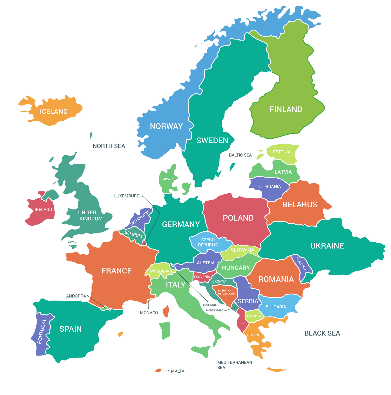A research project mapping cultural differences within Europe
Introduction
By removing trade barriers and border controls among its members states and the introduction of uniform standards, the European Union has become one big common market. But Europe still has one disadvantage compared with other big economic blocks, like the U.S. and China: the linguistic and cultural differences between the constituent countries. Research on cultural differences within Europe is therefore extremely valuable, because it can help to improve business relations between various countries and in that way boost trade and industrial collaboration within the union.
Mapping national cultures
Describing national cultures may be compared with making a map of a foreign country. All maps have strong and weak points, are adequate for one specific use and less so for other applications. Very popular in international busienss administration courses are the ‘Dimension models’ that try to define cultural differences between countries using ‘universal’ categories for comparison. Though they give a quick and easy overview of the main differences between two countries, they do not offer detailed explanations on how to act effectively in a foreign country and why people over there behave in that particular way. Much richer in detail and explanations are the (both popular and more serious) impressionistic descriptions of national countries, but they are often not based on a systematic analysis and difficult to put into practice. Our cultural map, being based on systematic research, will give detailed and practical information for foreigners, both describing how people behave on the work floor in the specific country and why.
Research method
Our research is based on a Grounded Interpretive Model (GIM). It is interpretive, as it makes use of a qualitative approach, aiming to produce a thick description of the contrasting national cultures that are studied (Geertz 1973). It describes in an anthropological way the typical behaviours in each of the two cultures, and tries to interpret them, identifying the cultural logic behind these typical behaviours (Iribarne 1989; 2002). It is grounded, as it makes use of Critical Incident Technique to identify cultural standards (typical behaviours) of each culture by a systematic analysis of critical incidents that are reported by nationals of one country working in another country, vice versa. Thus the research is focused on situations of amazement, friction, or embarassment, because these reveal differences in cultural behaviour and logic (Thomas 2010).
The project
Since the kick-off in 2020 several pilot studies have been started. A group of students of the University of Twente are writing their Master theses on the cultural differences which are experienced by European professionals working in other European countries than their home country. Several studies are now under way or have already been finalised: two studies on German-Dutch differences (as seen from the German perspective), a study on Dutch-German differences (from a Dutch perspective); two studies on Dutch-Spanish differences; and studies on Dutch-Polish, Dutch-French, Dutch-Italian, Dutch-English, Dutch-Belgian cultural differences (as seen from a Dutch perspective). In collaboration with the Nicolaus Copernicus University in Torún a research on Polish-Dutch cultural differences has been carried out.
We expect to engage in many more collaborations and studies in the future, and other European universities and their students are invited to join the project. Foreign students who are willing to write their Master thesis on this subject are provided with supplementary supervision from our side. The ideal situation is that the two students working on the same binational comparison from opposite perspectives help each each other in understanding the cultural logic leading to typical behaviours on both sides.
References:
Geertz, C. (1973). The interpretation of culture. New York: Basic Books
Iribarne, P.d’ (1989). La logique de l’honneur. Gestion d’entreprises et traditions nationales. Paris:Seuil.
Iribarne, P. d’ et al. (2002). Cultures et mondialisation. Gérer par-delà des frontières. Paris: Seuil
Thomas, A. et al. (2010). Handbook of intercultural communication and collaboration. Göttingen: Vandenhoeck & Ruprecht.

